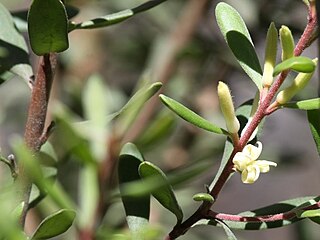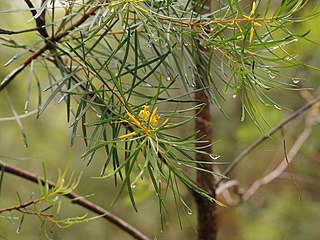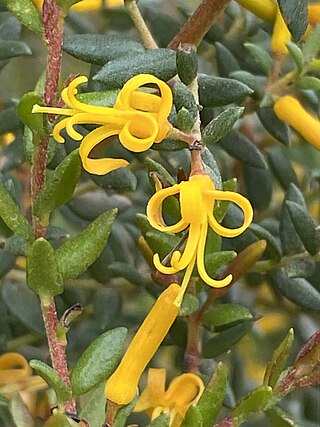
Persoonia cornifolia is a plant in the family Proteaceae and is endemic to eastern Australia. It is a shrub with elliptic to egg-shaped leaves and hairy yellow flowers, and grows in northern New South Wales and south-eastern Queensland.

Persoonia rigida, commonly known as the rigid-, hairy- or stiff geebung, is a species of flowering plant in the family Proteaceae and is endemic to south-eastern Australia. It is an erect to low-lying shrub with hairy young branchlets, lance-shaped to spatula-shaped leaves that are hairy when young, and yellow flowers borne in groups of up to twenty on a rachis up to 90 mm (3.5 in) long that continues to grow after flowering.

Persoonia subvelutina, commonly known as velvety geebung, is a plant in the family Proteaceae and is endemic to south-eastern Australia. It is a spreading to small tree with branchlets that are hairy when young, elliptic, lance-shaped, egg-shaped or spatula-shaped leaves and yellow flowers arranged singly in leaf axils on a pedicel 1–4 mm (0.039–0.157 in) long.

Persoonia confertiflora, commonly known as cluster-flower geebung, is a species of flowering plant in the family Proteaceae and is endemic to south-eastern Australia. It is an erect to low-lying shrub with hairy young branches, egg-shaped to narrow elliptic leaves, and hairy yellow flowers borne on leaf axils or on the ends of short branches.

Persoonia glaucescens, commonly known as the Mittagong geebung, is a species of flowering plant in the family Proteaceae and is endemic to New South Wales. It is an erect shrub with smooth bark, hairy young branchlets, lance-shaped leaves with the narrower end towards the base, and yellow flowers. It is the only persoonia in eastern Australia with strongly glaucous leaves.
Persoonia katerae is a plant in the family Proteaceae and is endemic to a small area on the coast of New South Wales. It is an erect shrub to small tree with smooth bark on the branches, narrow elliptic to lance-shaped leaves with the narrower end towards the base, and yellow flowers in groups of six to twenty-two on a rachis 30–160 mm (1.2–6.3 in) long.

Persoonia virgata is a species of flowering plant in the family Proteaceae and is endemic to coastal areas of eastern Australia. It is usually an erect shrub with smooth bark, hairy young branchlets, linear to narrow spatula-shaped leaves, and yellow flowers borne in groups of up to seventy-five on a rachis up to 230 mm (9.1 in) long that continues to grow after flowering.

Persoonia mollis, commonly known as soft geebung, is a plant in the family Proteaceae and is endemic to New South Wales. It is an erect to prostrate shrub with linear to oblong or spatula-shaped leaves, yellow flowers in groups of up to thirty on a rachis up to 150 mm (5.9 in) long and relatively small fruit.

Persoonia marginata, commonly known as the Clandulla geebung, is a plant in the family Proteaceae and is endemic to New South Wales. It is low, spreading shrub with elliptic to egg-shaped leaves and small groups of cylindrical yellow flowers.

Persoonia elliptica, commonly known as snottygobble or spreading snottygobble, is a plant in the family Proteaceae and is endemic to the south-west of Western Australia. It is an erect shrub or small tree with egg-shaped or lance-shaped leaves and groups of cylindrical yellow flowers. It usually grows in woodland or forest dominated by jarrah or marri within 50 km (30 mi) of the coast.

Persoonia asperula, commonly known as mountain geebung, is a plant in the family Proteaceae and is endemic to south-eastern Australia. It is an erect or prostrate shrub with smooth bark, mostly elliptic to oblong leaves and yellow flowers borne singly or in groups of up to nine. It mostly occurs in the Southern Highlands of New South Wales. A small population in Victoria may be a different species.

Persoonia isophylla is a plant in the family Proteaceae and is endemic to New South Wales. It is an erect or spreading shrub with soft, pine-like leaves and groups of cylindrical yellow flowers. It is similar to P. pinifolia but the flowers of that species have small leaves at their base, where the flowers of P. isophylla have full-sized leaves at their base. The two species sometimes grow together but hybrids between them are rare.

Persoonia oblongata is a plant in the family Proteaceae and is endemic to New South Wales. It is an erect to spreading shrub with narrow elliptic to broad egg-shaped leaves and yellow flowers on long, curved pedicels and is found from the lower Blue Mountains, west to Rylstone.

Persoonia conjuncta is a species of flowering plant in the family Lamiaceae and is endemic to eastern New South Wales. It is an erect shrub or small tree with narrow elliptic to lance-shaped leaves, yellow, tube-shaped flowers in groups of up to sixteen and green fruit.

Persoonia adenantha is a plant in the family Proteaceae and is endemic to eastern Australia. It is an upright shrub or small tree with smooth, elliptic to lance-shaped leaves and groups of hairy yellow flowers. It has sometimes been confused with P. cornifolia and P. stradbrokensis.

Persoonia brevifolia is a plant in the family Proteaceae and is endemic to a restricted area near the border between south-eastern New South Wales and Victoria. It is an erect shrub with elliptic to egg-shaped leaves and cylindrical yellow flowers arranged singly in leaf axils.

Persoonia acuminata is a plant in the family Proteaceae and is endemic to New South Wales. It is a spreading or prostrate shrub with relatively small leaves and cylindrical yellow flowers arranged singly or in groups of up to sixteen in leaf axils or on the ends of the branches. It grows in moist forest on the higher parts of the tablelands.

Persoonia recedens is a species of flowering plant in the family Proteaceae and is endemic to a restricted area of New South Wales. It is a spreading to low-lying shrub with hairy young branchlets, narrow oblong to narrow elliptic leaves, and yellow flowers borne in groups of up to twelve on a rachis up to 75 mm (3.0 in) that continues to grow after flowering.
Persoonia tropica is a plant in the family Proteaceae and is endemic to north Queensland. It is an erect shrub to small tree shrub with branchlets that are hairy when young, narrow elliptic to lance-shaped leaves and yellow flowers in groups of three to ten on a rachis 3–10 mm (0.12–0.39 in) long that continues to grow after flowering.

Persoonia comata is a species of flowering plant in the family Proteaceae and is endemic to the south-west of Western Australia. It is an erect, sometimes spreading to low-lying shrub with mostly smooth bark, spatula-shaped to lance-shaped leaves with the narrower end towards the base and yellow flowers usually in groups of ten to fifty along a rachis up to 250 mm (9.8 in) long.




















